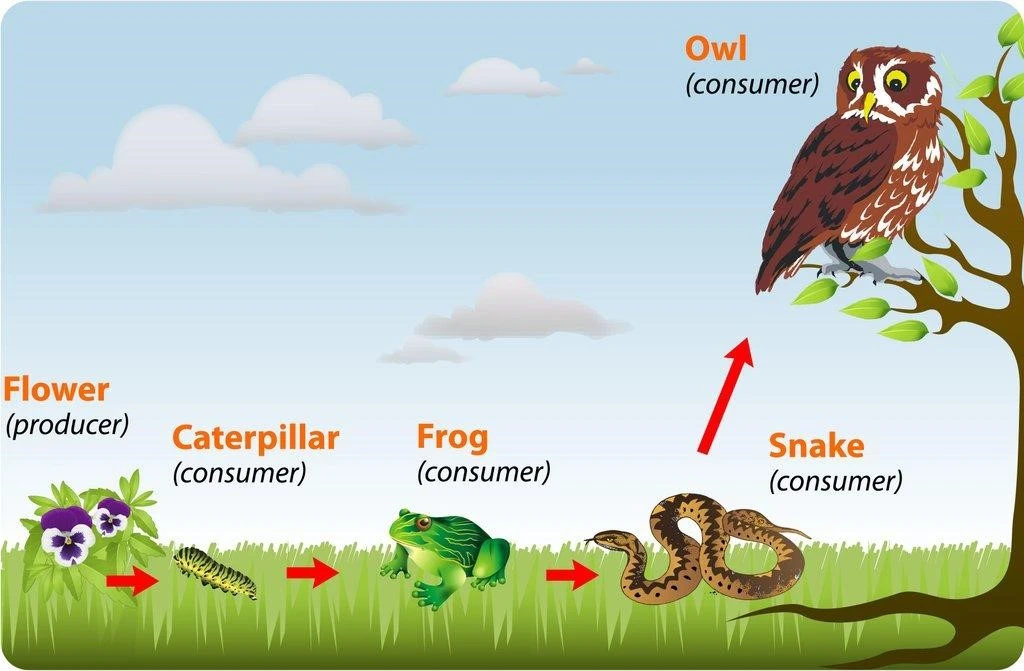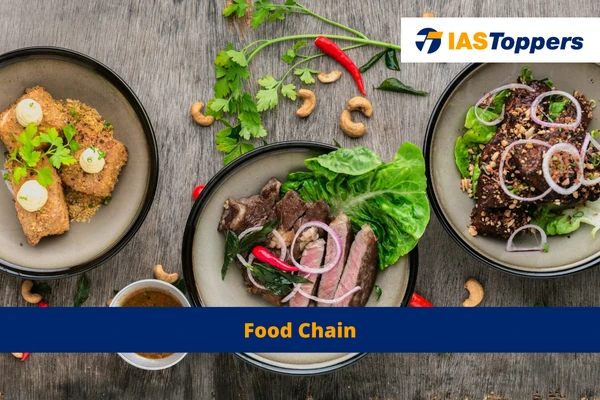Understanding the concept of food chains is important in comprehending the flow of energy through ecosystems. It depicts the transfer of food energy from producers to consumers, providing insights into the interconnectedness of organisms and their roles in sustaining life.
Food Chain will be helpful for UPSC IAS Exam preparation. GS Paper-3 Environment.
Table of Content
- What is Food Chain?
- Types of Food Chains
- Difference between grazing and detritus food chain
- Conclusion
- Frequently Asked Questions (FAQs)
What is Food Chain?
- Definition: The transfer of food energy from green plants (producers) through a series of organisms with repeated eating and being eaten is called a food chain.
- Examples: Grasses → Grasshopper → Frog → Snake → Hawk/Eagle
Types of Food Chains
Grazing Food Chains (GFCs)

Producers → Herbivores → Carnivores
- Definition: It is a type of food chain that always starts with primary producers like green plants, which create their own food through photosynthesis and later move from herbivores to carnivores.
Detritus Food Chains (DFCs)
Producers → Detritus Feeders → Carnivores
- Definition: It is the first trophic-level food chain that begins with dead organic material.
- Microorganisms are responsible for the decomposition of dead organic material in the detritus food chain.
- Detritivores are later eaten by predators in the detritus food chain.
- DFC are found in a variety of places such as the bottom of the ocean, sea, ponds, and lakes.
Difference between grazing and detritus food chain
The difference between grazing and detritus food chain is given below:
| Grazing Food Chains (GFCs) | Detritus Food Chains (DFCs) | |
| Definition | A food chain that starts with primary producers (green plants) and progresses from herbivores to carnivores. | The first trophic-level food chain that begins with dead organic material. |
| Initiating Organisms | Primary producers (green plants). | Dead organic material (detritus). |
| Decomposition | N/A | Microorganisms decompose dead organic material. |
| Consumers | Herbivores and carnivores. | Detritivores and carnivores. |
| Habitat | Varied habitats, including grasslands and forests. | Bottom of the ocean, sea, ponds, and lakes. |
Conclusion
While exploring food chains, we encounter various types, including Grazing Food Chains (GFC) and Detritus Food Chains (DFC). However, one challenge lies in preserving the delicate balance of these chains in the face of human activities and environmental changes. It is crucial to promote sustainable practices, conserve habitats, and raise awareness about the significance of preserving these intricate networks. By doing so, we can safeguard ecosystems and ensure the continued existence of diverse food chains for the benefit of all organisms.
Ref: Source-1
| Other Articles in Environment & Disaster Management | |
| Food Web | Ecological Pyramid |
| Energy Flow in Ecosystem | Phosphorus Cycle |
| Oxygen Cycle | Food Crops |
FAQs (Frequently Asked Questions)
What is the major difference between food chain and food web?
A food chain shows the linear flow of nutrients and energy from one trophic level to another. A food web is interconnected by many food chains at many trophic levels.
Who are the producers in a food chain?
The producers in a food chain are also known as autotrophs.
Why food chains in the ecosystem are important?
They helps to maintain and recycle biomass.
What are the examples of Detritus Food Chain?
Examples of the Detritus Food Chain are Dead phytoplankton and zooplankton, the outer walls of diatoms and coccolithophores, dead skin and scales of fish, and fecal pellets.
Give an example of an aquatic food chain.
In the aquatic ecosystem, the food chain begins with algae or phytoplankton as the primary producers. Zooplankton feed on them, and then they become food for small fish and crustaceans. These small fish are later consumed by larger fish, sharks, and even whales.


